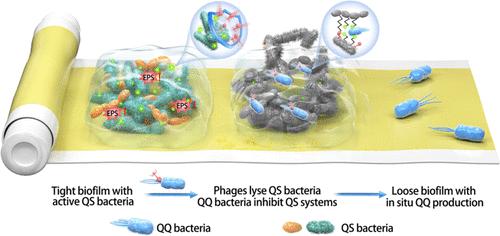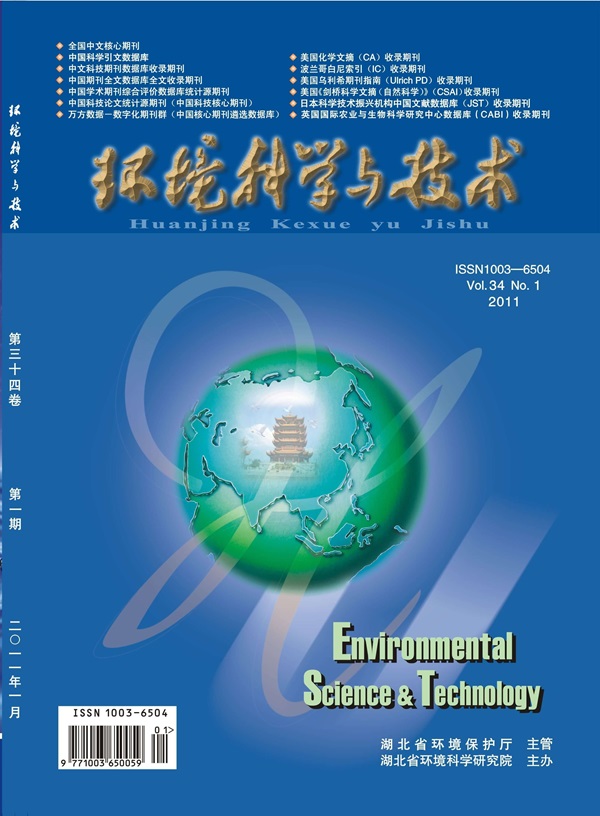Synergistic Treatment of Reverse Osmosis Membrane Biofouling with Quorum Quenching Bacteria and Hitchhiking Phages
IF 11.3
1区 环境科学与生态学
Q1 ENGINEERING, ENVIRONMENTAL
引用次数: 0
Abstract
Biofilm formation, which is facilitated by quorum sensing (QS), significantly impairs the performance of pressure-driven membrane systems in water treatment. Herein, we present a quorum quenching (QQ)-phage phoresy system to control biofouling by disrupting QS-mediated interactions. This system, which is composed of the QQ bacterium Paenarthrobacter nicotinovorans as carriers and hitchhiking lytic phages infecting Pseudomonas aeruginosa with active QS systems, significantly decreased QS signal levels, inhibited the extracellular polymeric substance (EPS), and reduced bacterial abundance in mature biofilms. Transcriptomic analysis revealed that phage treatment upregulated QS and EPS synthesis genes in P. aeruginosa, but the QQ bacteria downregulated QS-related genes, weakening the bacterial EPS secretion and antiviral systems and facilitating phages to infect and lyse the target bacteria. Metabolomic profiling corroborated that the phoresy system disrupted pathways critical to biofilm stability, including the tricarboxylic acid cycle, carbohydrate metabolism, and amino acid metabolism. In off-site membrane cleaning experiments, the phoresy system promoted P. nicotinovorans colonization and replaced the niche of P. aeruginosa on the membrane surface, which restored membrane flux (i.e., 90% recovery in severely biofouling systems). Operation studies showed that the phoresy system reduced fouling rates, extended the membrane lifespan, and maintained salt rejection performance for reverse osmosis (RO) membrane systems. These findings highlight the potential of the QQ bacterium-phage system as a sustainable alternative to conventional chemical treatments that damage polymeric membranes.

群体猝灭菌和搭便车噬菌体协同处理反渗透膜生物污染
生物膜的形成是由群体感应(QS)促进的,这极大地影响了压力驱动膜系统在水处理中的性能。在此,我们提出了一个群体猝灭(QQ)-噬菌体噬菌体系统,通过破坏群体猝灭介导的相互作用来控制生物污染。该系统以QQ细菌烟酸单胞杆菌为载体,搭便车溶菌感染铜绿假单胞菌,具有活性QS系统,可显著降低QS信号水平,抑制胞外聚合物质(EPS),降低成熟生物膜中的细菌丰度。转录组学分析显示,噬菌体处理上调了P. aeruginosa中QS和EPS合成基因,而QQ细菌下调了QS相关基因,削弱了细菌EPS分泌和抗病毒系统,促进了噬菌体感染和裂解靶菌。代谢组学分析证实,磷酸化系统破坏了对生物膜稳定性至关重要的途径,包括三羧酸循环、碳水化合物代谢和氨基酸代谢。在非现场的膜清洗实验中,磷磷系统促进了P. nicotinovorans的定植,取代了P. aeruginosa在膜表面的生态位,从而恢复了膜通量(在严重生物污染的系统中恢复了90%)。运行研究表明,磷质系统降低了反渗透(RO)膜系统的污染率,延长了膜的使用寿命,并保持了盐的抑制性能。这些发现突出了QQ噬菌体系统作为破坏聚合物膜的传统化学处理的可持续替代方案的潜力。
本文章由计算机程序翻译,如有差异,请以英文原文为准。
求助全文
约1分钟内获得全文
求助全文
来源期刊

环境科学与技术
环境科学-工程:环境
CiteScore
17.50
自引率
9.60%
发文量
12359
审稿时长
2.8 months
期刊介绍:
Environmental Science & Technology (ES&T) is a co-sponsored academic and technical magazine by the Hubei Provincial Environmental Protection Bureau and the Hubei Provincial Academy of Environmental Sciences.
Environmental Science & Technology (ES&T) holds the status of Chinese core journals, scientific papers source journals of China, Chinese Science Citation Database source journals, and Chinese Academic Journal Comprehensive Evaluation Database source journals. This publication focuses on the academic field of environmental protection, featuring articles related to environmental protection and technical advancements.
 求助内容:
求助内容: 应助结果提醒方式:
应助结果提醒方式:


